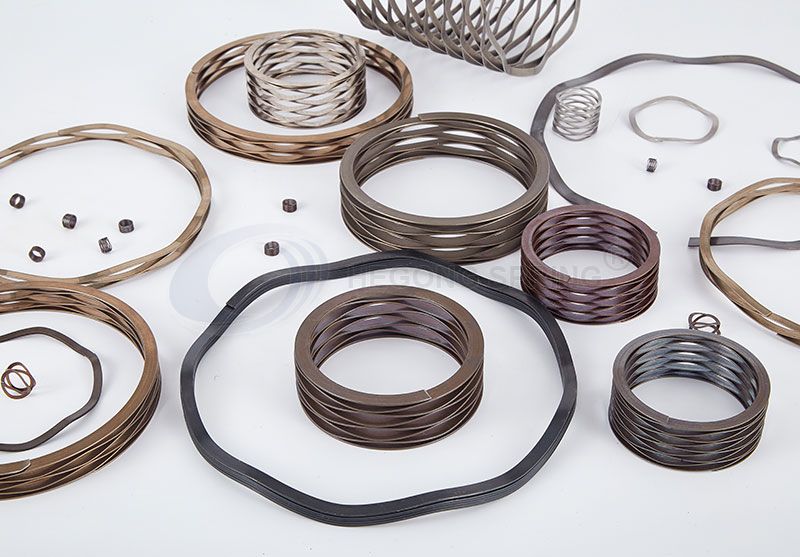Can You Stack Wave Springs?
In the realm of mechanical engineering, the use of wave springs has become increasingly popular due to their unique properties and versatility. Wave springs are known for their ability to provide precise control of force and work reliably in a wide range of applications. One common question that arises is, "Can you stack wave springs?" In this article, we will delve into the world of wave springs, explore the practicality of stacking them, and provide valuable insights for those seeking to harness their benefits effectively.

What are Wave Springs?
Before we delve into the practice of stacking wave springs, it's essential to understand the fundamental concept of wave springs. These springs are designed with a distinctive wavy or spiral shape, rather than the conventional coiled spring design. This design allows for a more compact and lightweight solution while still delivering exceptional load-bearing capabilities.
The Practicality of Stacking Wave Springs
Stacking wave springs is a technique used to fine-tune the force or deflection in various applications. The practicality of stacking wave springs lies in their adjustability and the ability to customize the desired performance. Whether you need to fine-tune a delicate electronic device or provide robust support in a heavy-duty industrial application, stacked wave springs can be a practical choice.
Benefits of Stacking Wave Springs
Stacking wave springs offers several advantages, including:
1. Precise Force Control
Stacking wave springs allows for precise force adjustment, making them suitable for applications with specific force requirements.
2. Enhanced Load-Bearing Capacity
By stacking wave springs, you can increase the load-bearing capacity without compromising on space or weight.
3. Improved Deflection Control
Stacking provides more flexibility in controlling deflection, allowing for better customization.
How to Stack Wave Springs
The process of stacking wave springs involves careful selection and arrangement of the springs to achieve the desired performance characteristics. To stack wave springs effectively, follow these steps:
Select wave springs of the appropriate size and type for your application.
Determine the number of wave springs required to achieve the desired force and deflection.
Arrange the wave springs in a series or parallel configuration, depending on your requirements.
Factors to Consider When Stacking Wave Springs
When considering stacking wave springs, it's important to keep these factors in mind:
Material Selection: Ensure that the materials of the wave springs are compatible with your application's environment.
Space Constraints: Consider the available space for stacking and whether it accommodates the selected configuration.
Load Requirements: Determine the specific load and deflection requirements for your application.
Common Applications
Stacked wave springs find application in various industries, including automotive, aerospace, medical devices, and more. Some common applications include:
Valve Actuation Systems
Shock Absorbers
Bearing Preload
Clutches and Brakes
Stacking vs. Using a Single Wave Spring
While stacking wave springs offers numerous advantages, there are instances where using a single wave spring may be more appropriate. It's crucial to understand when to opt for stacking and when a single wave spring will suffice.
Expert Tips for Effective Stacking
To achieve optimal results when stacking wave springs, consider these expert tips:
Consult with a wave spring manufacturer to ensure proper material selection.
Perform thorough testing to validate the effectiveness of your stacked configuration.
Monitor and maintain the stacked wave springs regularly to ensure long-term reliability.
Safety Considerations
When stacking wave springs, safety is paramount. Always adhere to safety guidelines and conduct risk assessments to prevent accidents or failures in your applications.
Conclusion
In conclusion, the ability to stack wave springs provides engineers with a versatile tool to meet the specific demands of their applications. Whether it's achieving precise force control, enhancing load-bearing capacity, or fine-tuning deflection, wave springs offer practicality and customization. By following the guidelines mentioned in this article, you can harness the full potential of stacked wave springs.
415
0
0
All Comments (0)
Previous: Why Collet Chucks Are a Game-Changer in 2023: Are They Worth Your Investment?
Next: Is Hardface Wire the Ultimate Solution for Your Industrial Needs?
If you are interested in sending in a Guest Blogger Submission,welcome to write for us!


Comments